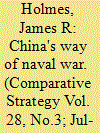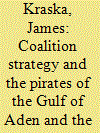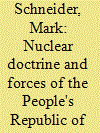| Srl | Item |
| 1 |
ID:
104088


|
|
|
|
|
| Publication |
2009.
|
| Summary/Abstract |
This article posits that Alfred Thayer Mahan supplies the "logic" of Chinese maritime strategy, urging Beijing to amass commercial and naval fleets, international commerce, and forward naval stations-the trappings of sea power. Mao Zedong provides the "grammar" by which the People's Liberation Army will prosecute naval operations offshore. The article ranks Wayne Hughes's three generic models of fleet tactics according to Chinese strategic preferences, concluding that Chinese commanders incline to dispersed attack, sequential attack, and massed attack, in that order. By acquainting themselves with Chinese preferences, U.S. naval commanders can glimpse how this prospective naval adversary will wage war.
|
|
|
|
|
|
|
|
|
|
|
|
|
|
|
|
| 2 |
ID:
104086


|
|
|
|
|
| Publication |
2009.
|
| Summary/Abstract |
The April 2009 seizure of the U.S.-flagged Motor Vessel Maersk Alabama and its twenty American crew members off the coast of Somalia should signal a change in counterpiracy strategy, away from a focus on major warship deployments by distant state major maritime powers, and toward development of a regional maritime security force constructed around numerous smaller patrol craft. Outside powers should focus on further advancing new international law and policy frameworks, which have become the most significant force multipliers for developing maritime security and offer the most effective approach to counterpiracy in the Horn of Africa. Complementing this effort will require a long-term program of regional maritime-security capacity building to support implementation of the new law and policy approaches. Piracy flourishes at the seams of globalization because jurisdiction is unclear and pirates exploit the inherent isolation of individual vessels and nations. Regional powers in the Horn of Africa have underdeveloped law enforcement and judicial systems and suffer from a severe lack of resources. In this setting, global and regional legal and policy frameworks in the areas of operational maritime security, judicial institutions, and law enforcement will be more effective in addressing piracy than adding another warship from an outside naval power to the equation.
|
|
|
|
|
|
|
|
|
|
|
|
|
|
|
|
| 3 |
ID:
104090


|
|
|
|
|
| Publication |
2009.
|
| Summary/Abstract |
There is an undeniable power surge in Asia, primarily in India and China. Speculation about a strategic joining of forces of India and China into a muscular economic alliance known as "Chindia" has been floated. Despite once being bitter enemies, the two nations have engaged in a recent détente with each other. Building upon each other's strengths helps advance this cause. However, until now the Chindia concept has appeared to be more theoretical than practical in nature because of lingering boundary issues between the nations. Such an alliance, however, cannot be summarily dismissed. This paper focuses upon how India and China partnering with the United States could form a transregional triangle that would tighten America's grip on power in the Asia-Pacific Region.
|
|
|
|
|
|
|
|
|
|
|
|
|
|
|
|
| 4 |
ID:
104089


|
|
|
|
|
| Publication |
2009.
|
| Summary/Abstract |
The People's Republic of China is the only member of the P-5 that is increasing both the quantity and quality of its nuclear forces. This nuclear buildup is in the context of military buildup that growing faster than any nation in the world. The China buildup is aimed a providing it a capability to dominate the Far East. The U.S. is regarded as main enemy and Chinese preparations are aimed at fight a major war against the United States.
|
|
|
|
|
|
|
|
|
|
|
|
|
|
|
|